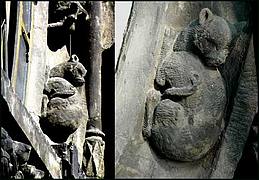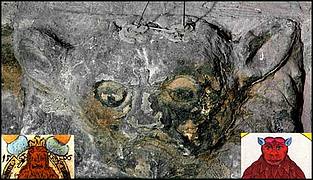
Symbology of the past … or the present as well? -
central part of the clock

Around the astrolabe, we can see a circular gallery of Parléř’ plastics. All of them are made as seen from above, some of them are very close to each other. Not all of them are identifiable, either due to time or due to their own fantastic character.
Those of them which are distinct represent a diverse animal
community. At the top of the circle there
lies a resting lion.
 A lion always has
an unequivocal position within
the animal kingdom in mythologies and symbologies – the position of the
king and guardian. It was regarded in this way by all civilizations
since the Stone Age. It emanates dignity even when resting. A real lion
can rest really well, it is used to resting twenty hours a day… and why
not, it is the king we are talking about. This is how it is depicted on
the clock as well. Close to the lion, there is another unequivocally
guardian animal, a dog.
It is assumed to be the first domesticated
animal. Besides vigilance and protection, it also represents fidelity.
As three-headed Cerberus, he guarded the entry to the nether world; a
black dog occurs in legends as a guardian of treasures. A dog at the
feet of a knight means natural death; death in fight was usually
symbolized by the well-proven lion. Christian ideologists somewhat
blotted the dog’s reputation because they adopted the wild, savage and
stray dogs as a symbol of foulness, bloodiness and grubbiness.
A lion always has
an unequivocal position within
the animal kingdom in mythologies and symbologies – the position of the
king and guardian. It was regarded in this way by all civilizations
since the Stone Age. It emanates dignity even when resting. A real lion
can rest really well, it is used to resting twenty hours a day… and why
not, it is the king we are talking about. This is how it is depicted on
the clock as well. Close to the lion, there is another unequivocally
guardian animal, a dog.
It is assumed to be the first domesticated
animal. Besides vigilance and protection, it also represents fidelity.
As three-headed Cerberus, he guarded the entry to the nether world; a
black dog occurs in legends as a guardian of treasures. A dog at the
feet of a knight means natural death; death in fight was usually
symbolized by the well-proven lion. Christian ideologists somewhat
blotted the dog’s reputation because they adopted the wild, savage and
stray dogs as a symbol of foulness, bloodiness and grubbiness.
 The
protective line cockerel-angel-lion-dog could be linked with the cat,
although it is in the lower part and quite distant from them. A cat
also sometimes guards treasures but it is not so reliable. It is a
symbol of independence, perhaps calculative and false attachment and
guilefulness. In ancient Egypt, cats were sacred animals; the Middle
Ages credited it with the salvation of the Noah’s Ark, when it caught
the mouse biting the ark’s wood. Black cat is a companion of magicians
and witches. On the astronomical clock, the cat has its head upright,
though it is somewhat deformed and over-rotated. It has a counterpart
on the clock, a panther
or a tiger – anyway, another cat –resting on
the western side on the same level.
The
protective line cockerel-angel-lion-dog could be linked with the cat,
although it is in the lower part and quite distant from them. A cat
also sometimes guards treasures but it is not so reliable. It is a
symbol of independence, perhaps calculative and false attachment and
guilefulness. In ancient Egypt, cats were sacred animals; the Middle
Ages credited it with the salvation of the Noah’s Ark, when it caught
the mouse biting the ark’s wood. Black cat is a companion of magicians
and witches. On the astronomical clock, the cat has its head upright,
though it is somewhat deformed and over-rotated. It has a counterpart
on the clock, a panther
or a tiger – anyway, another cat –resting on
the western side on the same level.
Next to the lion, there is a peculiar figure with a snake-like body
and a pointed and conical hat. The hat of a similar shape – the
Phrygian cap – is usually connected with the revolutionaries in France
in the 18th century. The name, however, originated in mythology, from
Phrygians and their King Midas.  It became a symbol of freedom in the
Roman Empire where the master granted his slave freedom and liberty by
giving him a hat. Parléř’s companions perhaps also considered the hat
as a symbol of exoneration and advancement, a metamorphosis from an
earthbound and profane snake
to a human. It would be quite convenient for us because there is no
clear symbol of a snake on the clock. Christianity attributed the snake
the position of a vile, earthbound, sinful, immoral and diabolic
creature – in other words, completely negative – creature, as well as a
tempter who gets defeated in every conflict. Thus the saint’s victory
over all impure powers is more distinct. Now we can easily proceed to dragons, also
creatures with a negative reputation. According to medieval
imagination, dragons evolved from snakes; they just developed wings and
one or more additional heads. The reinterpretation of the
symbols is perhaps most remarkable in the case of snakes and dragons
because in
ancient civilizations, and above all in China and Japan, they are
regarded as a symbol of the celestial sphere, rain, fertility and
power. It often appeared as a part of Emperors’ and supreme officials’
heraldry.
It became a symbol of freedom in the
Roman Empire where the master granted his slave freedom and liberty by
giving him a hat. Parléř’s companions perhaps also considered the hat
as a symbol of exoneration and advancement, a metamorphosis from an
earthbound and profane snake
to a human. It would be quite convenient for us because there is no
clear symbol of a snake on the clock. Christianity attributed the snake
the position of a vile, earthbound, sinful, immoral and diabolic
creature – in other words, completely negative – creature, as well as a
tempter who gets defeated in every conflict. Thus the saint’s victory
over all impure powers is more distinct. Now we can easily proceed to dragons, also
creatures with a negative reputation. According to medieval
imagination, dragons evolved from snakes; they just developed wings and
one or more additional heads. The reinterpretation of the
symbols is perhaps most remarkable in the case of snakes and dragons
because in
ancient civilizations, and above all in China and Japan, they are
regarded as a symbol of the celestial sphere, rain, fertility and
power. It often appeared as a part of Emperors’ and supreme officials’
heraldry.
 |
 |
 |
However, snakes and dragons did not lose their positive
values in spite
of all these slights. Since antiquity, Asclepius’ snake has remained to
be the symbol of doctors and pharmacists, and Wales has a beautiful red
dragon on its flag
 .
On the astronomical clock, there are two little
dragons; they discreetly support the lining of the astrolabe. They
appear to be almost harmless but the company around them is warning and
almost ominous. Are they warning us, mortals, who are approaching the
threshold of the nether world where dark powers rule and demons reside?
They are fallen angels, condemned by God. All ancient societies had
their experience with entering the nether world; let us remind
mythological Orpheus; Mascarons, fanciful faces with devilish
expressions, are quite common on Gothic cathedrals. They are usually
aloft; they repel and fight off dangerous external elements. An
element, flying by and seeing that the place is already engaged, looks
for another place to go. Similarly fanciful companions in their heights
are gargoyles. They repel by their appearance and their figural,
bestial and monstrous form is almost boundless. Let us leave aside the
fact that it was also a functional and practical device protecting the
brickwork against moisture. They are also present on the St. Vitus
Cathedral in large numbers; the cathedral was the main working place of
the Parléř’s stoneworks.
.
On the astronomical clock, there are two little
dragons; they discreetly support the lining of the astrolabe. They
appear to be almost harmless but the company around them is warning and
almost ominous. Are they warning us, mortals, who are approaching the
threshold of the nether world where dark powers rule and demons reside?
They are fallen angels, condemned by God. All ancient societies had
their experience with entering the nether world; let us remind
mythological Orpheus; Mascarons, fanciful faces with devilish
expressions, are quite common on Gothic cathedrals. They are usually
aloft; they repel and fight off dangerous external elements. An
element, flying by and seeing that the place is already engaged, looks
for another place to go. Similarly fanciful companions in their heights
are gargoyles. They repel by their appearance and their figural,
bestial and monstrous form is almost boundless. Let us leave aside the
fact that it was also a functional and practical device protecting the
brickwork against moisture. They are also present on the St. Vitus
Cathedral in large numbers; the cathedral was the main working place of
the Parléř’s stoneworks.
These stone monsters are poorly visible in their heights. The
astronomical clock is, in this scale, a miniature and thus we can watch
them closely, from a few metres. Similarly, they can watch us,
short-living creatures, and they warn us that the boundary is right
here. They are accompanied by earthbound and night creatures. A
sleeping bat with a reputation of a vampire, a transformed devil, which
drinks blood and can transform into other animals. A frog, a Christian
symbol of sin and heretics, who remain – in the form of frogs
- in mud
and croak off their lies.  This animal also suffered from an
alteration
in interpretation. In ancient Egypt a frog was a symbol of salvation,
resurrection and long life. A hedgehog is also a night creature; it is
considered to be a protector of household happiness but its
fastidiousness, greediness and even aggressiveness and anger
prevail. A
misshapen face on the east and a wild man on the west considerably
emphasize the warning signals against dark powers. A wild man, no
matter if it is a forest man, green man, fiery man or Pan of ancient
Greeks, has always been a symbol of natural, forest and underworld
powers.
This animal also suffered from an
alteration
in interpretation. In ancient Egypt a frog was a symbol of salvation,
resurrection and long life. A hedgehog is also a night creature; it is
considered to be a protector of household happiness but its
fastidiousness, greediness and even aggressiveness and anger
prevail. A
misshapen face on the east and a wild man on the west considerably
emphasize the warning signals against dark powers. A wild man, no
matter if it is a forest man, green man, fiery man or Pan of ancient
Greeks, has always been a symbol of natural, forest and underworld
powers.

And in the centre, there is a devil, underneath the astrolabe, the circle of the world, on the very edge of his realm. An animal face with his ears pricked up and menacingly bulging eyes. He is on his own, as if he did not need any other companions. Again, let us remind the skeleton once again, although we have already mentioned it several times. Let us not consider it a symbol of death and the end but a warning that all things around us are evanescent. From the moment of our birth, we are approaching the end, the mundane end. The bell and sandglass emphasize its Memento mori. Just like the ancient Chronos, the god of time. Our skeleton dates back to Gothic era but it was not until Baroque when this symbolic message was fully developed.
